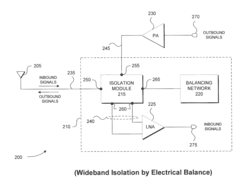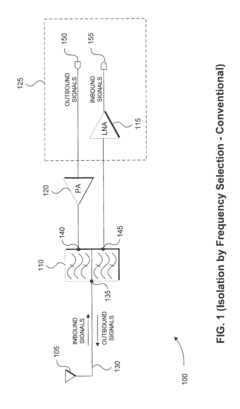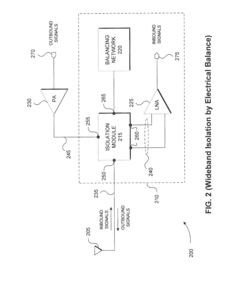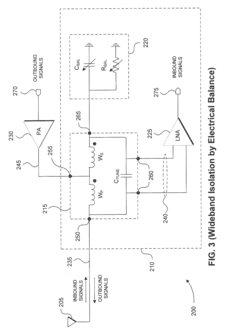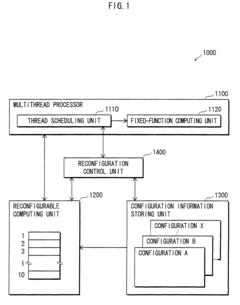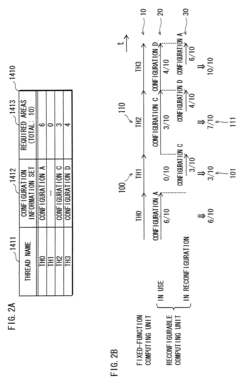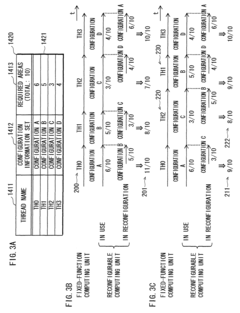How to Align Multiplexer Functionality with Industry Standards?
JUL 13, 20259 MIN READ
Generate Your Research Report Instantly with AI Agent
Patsnap Eureka helps you evaluate technical feasibility & market potential.
Multiplexer Standards Evolution and Objectives
Multiplexer technology has undergone significant evolution since its inception in the mid-20th century. Initially developed for telecommunications, multiplexers have become integral components in various industries, including data communications, aerospace, and automotive sectors. The primary objective of multiplexer technology has been to efficiently combine multiple input signals into a single output stream, maximizing bandwidth utilization and reducing infrastructure costs.
The evolution of multiplexer standards has been driven by the increasing demand for higher data rates, improved signal integrity, and greater flexibility in network configurations. Early multiplexing techniques, such as Time Division Multiplexing (TDM) and Frequency Division Multiplexing (FDM), laid the foundation for more advanced standards. As digital communication became prevalent, standards like SONET/SDH emerged, providing synchronous multiplexing capabilities for optical networks.
In recent years, the focus has shifted towards packet-based multiplexing standards to accommodate the growing Internet Protocol (IP) traffic. Ethernet-based multiplexing technologies, such as Carrier Ethernet and MPLS-TP, have gained prominence due to their scalability and cost-effectiveness. These standards aim to seamlessly integrate with existing IP infrastructures while maintaining carrier-grade reliability and performance.
The objectives of modern multiplexer standards extend beyond mere signal combination. They now encompass features like Quality of Service (QoS) management, traffic prioritization, and advanced error correction mechanisms. Industry standards bodies, such as IEEE, ITU-T, and IETF, play crucial roles in defining and refining these standards to ensure interoperability and consistent performance across different vendor implementations.
Aligning multiplexer functionality with industry standards has become increasingly critical in today's interconnected world. This alignment ensures that multiplexers can operate seamlessly within diverse network environments, support emerging technologies like 5G and IoT, and meet stringent regulatory requirements. The objectives of current standardization efforts include enhancing energy efficiency, improving security features, and supporting software-defined networking (SDN) capabilities.
As we look towards the future, the evolution of multiplexer standards is expected to continue, driven by the need for higher bandwidth, lower latency, and more flexible network architectures. Emerging technologies like quantum multiplexing and AI-driven adaptive multiplexing are on the horizon, promising to revolutionize the field further. The ongoing challenge lies in developing standards that can keep pace with rapid technological advancements while maintaining backward compatibility and ensuring smooth transitions for existing infrastructure.
The evolution of multiplexer standards has been driven by the increasing demand for higher data rates, improved signal integrity, and greater flexibility in network configurations. Early multiplexing techniques, such as Time Division Multiplexing (TDM) and Frequency Division Multiplexing (FDM), laid the foundation for more advanced standards. As digital communication became prevalent, standards like SONET/SDH emerged, providing synchronous multiplexing capabilities for optical networks.
In recent years, the focus has shifted towards packet-based multiplexing standards to accommodate the growing Internet Protocol (IP) traffic. Ethernet-based multiplexing technologies, such as Carrier Ethernet and MPLS-TP, have gained prominence due to their scalability and cost-effectiveness. These standards aim to seamlessly integrate with existing IP infrastructures while maintaining carrier-grade reliability and performance.
The objectives of modern multiplexer standards extend beyond mere signal combination. They now encompass features like Quality of Service (QoS) management, traffic prioritization, and advanced error correction mechanisms. Industry standards bodies, such as IEEE, ITU-T, and IETF, play crucial roles in defining and refining these standards to ensure interoperability and consistent performance across different vendor implementations.
Aligning multiplexer functionality with industry standards has become increasingly critical in today's interconnected world. This alignment ensures that multiplexers can operate seamlessly within diverse network environments, support emerging technologies like 5G and IoT, and meet stringent regulatory requirements. The objectives of current standardization efforts include enhancing energy efficiency, improving security features, and supporting software-defined networking (SDN) capabilities.
As we look towards the future, the evolution of multiplexer standards is expected to continue, driven by the need for higher bandwidth, lower latency, and more flexible network architectures. Emerging technologies like quantum multiplexing and AI-driven adaptive multiplexing are on the horizon, promising to revolutionize the field further. The ongoing challenge lies in developing standards that can keep pace with rapid technological advancements while maintaining backward compatibility and ensuring smooth transitions for existing infrastructure.
Market Demand Analysis for Standardized Multiplexers
The market demand for standardized multiplexers has been steadily increasing across various industries, driven by the need for efficient data transmission and network optimization. As telecommunications networks continue to expand and evolve, the requirement for multiplexers that adhere to industry standards has become paramount. This demand is particularly evident in sectors such as telecommunications, data centers, and industrial automation.
In the telecommunications industry, the proliferation of 5G networks has significantly boosted the demand for standardized multiplexers. These devices play a crucial role in managing the increased data traffic and optimizing bandwidth utilization. The market for 5G-compatible multiplexers is expected to grow substantially as more countries roll out their 5G infrastructure.
Data centers represent another major market segment driving the demand for standardized multiplexers. With the exponential growth of cloud computing and big data analytics, data centers require high-performance multiplexers that can handle massive data volumes while maintaining compatibility with existing systems. The need for energy-efficient solutions in data centers further emphasizes the importance of standardized multiplexers that can optimize power consumption.
The industrial automation sector is also experiencing a surge in demand for standardized multiplexers. As factories and manufacturing plants increasingly adopt Industry 4.0 technologies, the need for reliable and interoperable communication systems has grown. Standardized multiplexers enable seamless integration of various industrial control systems and sensors, facilitating real-time data exchange and process optimization.
The automotive industry is emerging as a significant market for standardized multiplexers, particularly with the rise of connected and autonomous vehicles. These advanced vehicles require robust communication systems that can handle multiple data streams simultaneously, making standardized multiplexers essential components in automotive networking solutions.
Market analysis indicates that the Asia-Pacific region is expected to witness the highest growth rate in the demand for standardized multiplexers. This trend is attributed to the rapid digitalization of economies in countries like China, India, and South Korea, coupled with substantial investments in 5G infrastructure and smart city initiatives.
The increasing adoption of Internet of Things (IoT) devices across various sectors is another key factor driving the demand for standardized multiplexers. As the number of connected devices continues to grow exponentially, the need for efficient data aggregation and transmission becomes critical, further boosting the market for standardized multiplexing solutions.
Overall, the market demand for standardized multiplexers is projected to maintain a strong growth trajectory in the coming years. This trend is underpinned by the ongoing digital transformation across industries, the expansion of high-speed communication networks, and the increasing emphasis on interoperability and efficiency in data transmission systems.
In the telecommunications industry, the proliferation of 5G networks has significantly boosted the demand for standardized multiplexers. These devices play a crucial role in managing the increased data traffic and optimizing bandwidth utilization. The market for 5G-compatible multiplexers is expected to grow substantially as more countries roll out their 5G infrastructure.
Data centers represent another major market segment driving the demand for standardized multiplexers. With the exponential growth of cloud computing and big data analytics, data centers require high-performance multiplexers that can handle massive data volumes while maintaining compatibility with existing systems. The need for energy-efficient solutions in data centers further emphasizes the importance of standardized multiplexers that can optimize power consumption.
The industrial automation sector is also experiencing a surge in demand for standardized multiplexers. As factories and manufacturing plants increasingly adopt Industry 4.0 technologies, the need for reliable and interoperable communication systems has grown. Standardized multiplexers enable seamless integration of various industrial control systems and sensors, facilitating real-time data exchange and process optimization.
The automotive industry is emerging as a significant market for standardized multiplexers, particularly with the rise of connected and autonomous vehicles. These advanced vehicles require robust communication systems that can handle multiple data streams simultaneously, making standardized multiplexers essential components in automotive networking solutions.
Market analysis indicates that the Asia-Pacific region is expected to witness the highest growth rate in the demand for standardized multiplexers. This trend is attributed to the rapid digitalization of economies in countries like China, India, and South Korea, coupled with substantial investments in 5G infrastructure and smart city initiatives.
The increasing adoption of Internet of Things (IoT) devices across various sectors is another key factor driving the demand for standardized multiplexers. As the number of connected devices continues to grow exponentially, the need for efficient data aggregation and transmission becomes critical, further boosting the market for standardized multiplexing solutions.
Overall, the market demand for standardized multiplexers is projected to maintain a strong growth trajectory in the coming years. This trend is underpinned by the ongoing digital transformation across industries, the expansion of high-speed communication networks, and the increasing emphasis on interoperability and efficiency in data transmission systems.
Current Challenges in Multiplexer Standardization
The standardization of multiplexer functionality presents several significant challenges in today's rapidly evolving telecommunications and networking industries. One of the primary obstacles is the diverse range of existing multiplexer technologies and protocols, each developed to meet specific industry needs. This diversity has led to interoperability issues, making it difficult for equipment from different manufacturers to work seamlessly together.
Another major challenge is the rapid pace of technological advancement in the field of multiplexing. As new technologies emerge, such as advanced optical multiplexing techniques and software-defined networking (SDN), industry standards struggle to keep up. This lag between innovation and standardization creates a gap where cutting-edge solutions may not align with established norms, potentially hindering their adoption and integration into existing networks.
The increasing complexity of multiplexer systems also poses a significant hurdle in standardization efforts. Modern multiplexers often incorporate advanced features like dynamic bandwidth allocation, quality of service (QoS) management, and integrated security measures. Developing comprehensive standards that address all these aspects while remaining flexible enough to accommodate future innovations is a daunting task for standardization bodies.
Furthermore, the global nature of the telecommunications industry introduces geopolitical and regulatory challenges. Different regions and countries may have varying requirements and regulations governing multiplexer functionality, making it difficult to establish truly universal standards. This fragmentation can lead to increased costs for manufacturers who must develop region-specific versions of their products to comply with local standards.
The backward compatibility requirement presents another significant challenge. As new standards are developed, they must consider the vast installed base of legacy equipment. Ensuring that new multiplexer standards can coexist with older systems without disrupting existing networks is crucial but often technically challenging and economically burdensome.
Lastly, the convergence of different network types, such as mobile, fixed-line, and satellite communications, adds another layer of complexity to multiplexer standardization. Creating standards that can effectively address the unique requirements of each network type while promoting interoperability across these diverse platforms is a complex undertaking that requires extensive collaboration between industry stakeholders.
Another major challenge is the rapid pace of technological advancement in the field of multiplexing. As new technologies emerge, such as advanced optical multiplexing techniques and software-defined networking (SDN), industry standards struggle to keep up. This lag between innovation and standardization creates a gap where cutting-edge solutions may not align with established norms, potentially hindering their adoption and integration into existing networks.
The increasing complexity of multiplexer systems also poses a significant hurdle in standardization efforts. Modern multiplexers often incorporate advanced features like dynamic bandwidth allocation, quality of service (QoS) management, and integrated security measures. Developing comprehensive standards that address all these aspects while remaining flexible enough to accommodate future innovations is a daunting task for standardization bodies.
Furthermore, the global nature of the telecommunications industry introduces geopolitical and regulatory challenges. Different regions and countries may have varying requirements and regulations governing multiplexer functionality, making it difficult to establish truly universal standards. This fragmentation can lead to increased costs for manufacturers who must develop region-specific versions of their products to comply with local standards.
The backward compatibility requirement presents another significant challenge. As new standards are developed, they must consider the vast installed base of legacy equipment. Ensuring that new multiplexer standards can coexist with older systems without disrupting existing networks is crucial but often technically challenging and economically burdensome.
Lastly, the convergence of different network types, such as mobile, fixed-line, and satellite communications, adds another layer of complexity to multiplexer standardization. Creating standards that can effectively address the unique requirements of each network type while promoting interoperability across these diverse platforms is a complex undertaking that requires extensive collaboration between industry stakeholders.
Existing Multiplexer Alignment Solutions
01 Signal selection and routing
Multiplexers are used to select and route signals from multiple input channels to a single output channel. They allow for efficient data transmission and processing by combining multiple data streams into a single stream. This functionality is crucial in various applications, including telecommunications, data processing, and digital systems.- Signal selection and routing: Multiplexers are used to select and route signals from multiple input channels to a single output channel. They allow for efficient data transmission and processing by combining multiple data streams into a single stream. This functionality is crucial in various applications, including telecommunications, digital signal processing, and computer systems.
- Power management and efficiency: Multiplexers play a role in power management by enabling selective activation of circuit components. This functionality helps reduce power consumption in electronic devices by allowing unused components to be powered down when not in use. Advanced multiplexer designs incorporate features to optimize power efficiency in various operating modes.
- Optical signal multiplexing: In optical communication systems, multiplexers are used to combine multiple optical signals onto a single fiber. This allows for increased data transmission capacity and efficient use of optical network infrastructure. Optical multiplexers can handle different wavelengths or modes of light, enabling technologies such as wavelength-division multiplexing (WDM).
- Reconfigurable logic and FPGA integration: Multiplexers are essential components in reconfigurable logic devices such as Field-Programmable Gate Arrays (FPGAs). They enable dynamic routing of signals and implementation of complex logic functions. The ability to reconfigure multiplexer connections allows for flexible and adaptable hardware designs in various applications.
- Time-division multiplexing: Time-division multiplexing (TDM) is a technique where multiple data streams are transmitted over a single channel by allocating time slots to each stream. Multiplexers implementing TDM functionality allow for efficient use of communication channels by interleaving data from multiple sources. This approach is widely used in telecommunications and digital communication systems.
02 Power management and clock distribution
Multiplexers play a role in power management and clock distribution systems. They can be used to select and distribute clock signals to different parts of a circuit, enabling efficient power usage and synchronization. This functionality is particularly important in low-power designs and complex digital systems.Expand Specific Solutions03 Optical signal multiplexing
In optical communication systems, multiplexers are used to combine multiple optical signals onto a single fiber. This allows for increased bandwidth and efficient use of optical transmission resources. Optical multiplexers can handle different wavelengths or modes of light, enabling high-speed data transmission over long distances.Expand Specific Solutions04 Reconfigurable logic and FPGA applications
Multiplexers are essential components in reconfigurable logic devices such as Field-Programmable Gate Arrays (FPGAs). They enable dynamic routing of signals and implementation of various logic functions. This flexibility allows for the creation of custom digital circuits and rapid prototyping of complex systems.Expand Specific Solutions05 Analog signal multiplexing
Multiplexers are used in analog systems to switch between multiple analog input signals. This functionality is important in data acquisition systems, sensor interfaces, and audio/video applications. Analog multiplexers can handle a wide range of signal types and frequencies, allowing for versatile signal processing and routing.Expand Specific Solutions
Key Industry Players and Standardization Bodies
The alignment of multiplexer functionality with industry standards is currently in a mature phase, with a well-established market and significant competition among key players. The global market size for multiplexers is substantial, driven by increasing demand for high-speed data transmission and network optimization. Major companies like Huawei, ZTE, NEC, and Fujitsu are at the forefront of technological advancements, offering sophisticated multiplexing solutions that adhere to international standards. These industry leaders continually invest in R&D to enhance performance, efficiency, and compatibility, ensuring their products meet evolving industry requirements and maintain interoperability across diverse network infrastructures.
ZTE Corp.
Technical Solution: ZTE's approach to aligning multiplexer functionality with industry standards focuses on versatility and efficiency. Their multiplexers are designed to support a wide range of network technologies, from legacy systems to the latest 5G standards. ZTE has implemented flexible multiplexing schemes that can adapt to different network architectures, including centralized and distributed RAN configurations[13]. Their multiplexers incorporate advanced signal processing techniques to improve spectral efficiency while maintaining compliance with 3GPP standards[14]. ZTE has also developed intelligent network management systems for their multiplexers, enabling automated optimization and alignment with evolving industry standards[15].
Strengths: High versatility across network generations, advanced signal processing capabilities, and intelligent network management. Weaknesses: Potential challenges in some markets due to geopolitical concerns, and possible trade-offs between versatility and specialized performance in specific scenarios.
NEC Corp.
Technical Solution: NEC has focused on developing multiplexer technologies that adhere to industry standards while pushing the boundaries of performance. Their approach includes the implementation of software-defined networking (SDN) principles in multiplexer design, allowing for greater flexibility and programmability[4]. NEC's multiplexers utilize advanced optical technologies, such as wavelength division multiplexing (WDM), to increase bandwidth capacity while maintaining compliance with ITU-T standards[5]. They have also integrated machine learning algorithms to optimize traffic routing and reduce latency in real-time, ensuring that their multiplexers can adapt to changing network conditions while maintaining alignment with industry norms[6].
Strengths: Strong integration of SDN principles, advanced optical technologies, and adaptive machine learning capabilities. Weaknesses: Potentially higher costs due to cutting-edge technologies, and possible complexity in implementation for smaller networks.
Core Innovations in Multiplexer Standardization
RF front-end with wideband transmitter/receiver isolation
PatentActiveUS20150071132A1
Innovation
- A silicon-based duplexer functional circuit is developed that provides isolation using frequency selection or electrical balance, allowing for integration on the same IC and supporting multiple frequency bands, reducing the need for off-chip components.
Processor capable of reconfiguring a logical circuit
PatentInactiveUS7926055B2
Innovation
- A processor with a reconfigurable integrated circuit that cyclically executes threads using a reconfiguration unit, configuration information storing unit, control unit, and selection unit, allowing for dynamic reconfiguration of the circuit based on thread-specific configuration information sets, enabling efficient execution of threads without requiring extensive reconfiguration during processing.
Interoperability and Compatibility Considerations
Interoperability and compatibility are crucial considerations when aligning multiplexer functionality with industry standards. The ability of multiplexers to seamlessly integrate with various systems and adhere to established protocols is essential for ensuring widespread adoption and long-term viability in the market.
One of the primary challenges in achieving interoperability is the diverse range of communication protocols used across different industries and applications. Multiplexers must be designed to support multiple protocols, such as Ethernet, SONET/SDH, and Fibre Channel, to facilitate seamless data transmission between disparate systems. This multi-protocol support enables multiplexers to serve as versatile components in complex network architectures, bridging gaps between legacy systems and modern infrastructure.
Compatibility with existing hardware and software systems is another critical aspect of aligning multiplexer functionality with industry standards. Manufacturers must ensure that their multiplexers can interface with a wide array of devices, including routers, switches, and network management systems. This compatibility extends to supporting various data formats, signal types, and transmission rates, allowing for flexible deployment across different network environments.
Adherence to industry standards, such as those set by the International Telecommunication Union (ITU) and the Institute of Electrical and Electronics Engineers (IEEE), is paramount for ensuring interoperability. These standards define specifications for data transmission, signal quality, and network management, providing a common framework for manufacturers and system integrators. By complying with these standards, multiplexer manufacturers can guarantee that their products will function reliably within standardized network architectures.
The implementation of open interfaces and standardized management protocols is essential for enabling seamless integration with network management systems. Protocols such as SNMP (Simple Network Management Protocol) and NETCONF (Network Configuration Protocol) allow for centralized monitoring, configuration, and troubleshooting of multiplexers within larger network ecosystems. This standardization simplifies network management tasks and reduces operational complexity for end-users.
Future-proofing multiplexer designs is a critical consideration in the rapidly evolving telecommunications landscape. Manufacturers must anticipate emerging standards and technologies, incorporating flexibility and scalability into their products. This foresight ensures that multiplexers can adapt to new requirements and maintain compatibility with future network innovations, protecting investments and extending the lifespan of deployed systems.
In conclusion, aligning multiplexer functionality with industry standards requires a multifaceted approach that addresses interoperability, compatibility, and adherence to established protocols. By focusing on these key areas, manufacturers can develop multiplexers that seamlessly integrate into diverse network environments, meet the evolving needs of the industry, and provide long-term value to end-users.
One of the primary challenges in achieving interoperability is the diverse range of communication protocols used across different industries and applications. Multiplexers must be designed to support multiple protocols, such as Ethernet, SONET/SDH, and Fibre Channel, to facilitate seamless data transmission between disparate systems. This multi-protocol support enables multiplexers to serve as versatile components in complex network architectures, bridging gaps between legacy systems and modern infrastructure.
Compatibility with existing hardware and software systems is another critical aspect of aligning multiplexer functionality with industry standards. Manufacturers must ensure that their multiplexers can interface with a wide array of devices, including routers, switches, and network management systems. This compatibility extends to supporting various data formats, signal types, and transmission rates, allowing for flexible deployment across different network environments.
Adherence to industry standards, such as those set by the International Telecommunication Union (ITU) and the Institute of Electrical and Electronics Engineers (IEEE), is paramount for ensuring interoperability. These standards define specifications for data transmission, signal quality, and network management, providing a common framework for manufacturers and system integrators. By complying with these standards, multiplexer manufacturers can guarantee that their products will function reliably within standardized network architectures.
The implementation of open interfaces and standardized management protocols is essential for enabling seamless integration with network management systems. Protocols such as SNMP (Simple Network Management Protocol) and NETCONF (Network Configuration Protocol) allow for centralized monitoring, configuration, and troubleshooting of multiplexers within larger network ecosystems. This standardization simplifies network management tasks and reduces operational complexity for end-users.
Future-proofing multiplexer designs is a critical consideration in the rapidly evolving telecommunications landscape. Manufacturers must anticipate emerging standards and technologies, incorporating flexibility and scalability into their products. This foresight ensures that multiplexers can adapt to new requirements and maintain compatibility with future network innovations, protecting investments and extending the lifespan of deployed systems.
In conclusion, aligning multiplexer functionality with industry standards requires a multifaceted approach that addresses interoperability, compatibility, and adherence to established protocols. By focusing on these key areas, manufacturers can develop multiplexers that seamlessly integrate into diverse network environments, meet the evolving needs of the industry, and provide long-term value to end-users.
Regulatory Compliance for Multiplexer Standards
Regulatory compliance for multiplexer standards is a critical aspect of ensuring that multiplexer functionality aligns with industry requirements. The telecommunications industry, in particular, relies heavily on multiplexers to combine multiple data streams into a single transmission channel, making compliance with established standards essential for interoperability and performance.
One of the primary regulatory bodies governing multiplexer standards is the International Telecommunication Union (ITU). The ITU-T G.703 recommendation, for instance, specifies the physical and electrical characteristics of hierarchical digital interfaces. Multiplexers must adhere to these specifications to ensure compatibility with other network equipment and to maintain signal integrity across various transmission mediums.
The European Telecommunications Standards Institute (ETSI) also plays a crucial role in defining multiplexer standards, particularly for European markets. ETSI standards cover aspects such as synchronization, framing, and error correction mechanisms, which are vital for multiplexer operation in diverse network environments.
In the United States, the Federal Communications Commission (FCC) regulates telecommunications equipment, including multiplexers. FCC Part 15 rules govern electromagnetic compatibility (EMC) and radio frequency interference (RFI) emissions, ensuring that multiplexers do not cause harmful interference to other devices or networks.
Compliance with these standards often requires rigorous testing and certification processes. Manufacturers must subject their multiplexer designs to a battery of tests, including bit error rate (BER) measurements, jitter tolerance assessments, and EMC evaluations. Third-party testing laboratories typically conduct these tests to verify compliance and issue certifications.
The IEEE 802.3 standard, which defines Ethernet protocols, is another crucial consideration for multiplexer compliance, especially in data networking applications. As networks evolve towards higher speeds and greater complexity, multiplexers must adapt to support emerging Ethernet standards while maintaining backward compatibility.
Security standards are becoming increasingly important in multiplexer design and implementation. The ISO/IEC 27001 information security management standard provides a framework for protecting sensitive data transmitted through multiplexed channels. Compliance with such standards is particularly critical in sectors handling sensitive information, such as finance and healthcare.
As the industry moves towards software-defined networking (SDN) and network function virtualization (NFV), new standards are emerging to govern the virtualization of multiplexer functions. The European Telecommunications Standards Institute (ETSI) NFV Industry Specification Group (ISG) is at the forefront of developing these standards, which will shape the future of multiplexer technology and its integration into next-generation networks.
One of the primary regulatory bodies governing multiplexer standards is the International Telecommunication Union (ITU). The ITU-T G.703 recommendation, for instance, specifies the physical and electrical characteristics of hierarchical digital interfaces. Multiplexers must adhere to these specifications to ensure compatibility with other network equipment and to maintain signal integrity across various transmission mediums.
The European Telecommunications Standards Institute (ETSI) also plays a crucial role in defining multiplexer standards, particularly for European markets. ETSI standards cover aspects such as synchronization, framing, and error correction mechanisms, which are vital for multiplexer operation in diverse network environments.
In the United States, the Federal Communications Commission (FCC) regulates telecommunications equipment, including multiplexers. FCC Part 15 rules govern electromagnetic compatibility (EMC) and radio frequency interference (RFI) emissions, ensuring that multiplexers do not cause harmful interference to other devices or networks.
Compliance with these standards often requires rigorous testing and certification processes. Manufacturers must subject their multiplexer designs to a battery of tests, including bit error rate (BER) measurements, jitter tolerance assessments, and EMC evaluations. Third-party testing laboratories typically conduct these tests to verify compliance and issue certifications.
The IEEE 802.3 standard, which defines Ethernet protocols, is another crucial consideration for multiplexer compliance, especially in data networking applications. As networks evolve towards higher speeds and greater complexity, multiplexers must adapt to support emerging Ethernet standards while maintaining backward compatibility.
Security standards are becoming increasingly important in multiplexer design and implementation. The ISO/IEC 27001 information security management standard provides a framework for protecting sensitive data transmitted through multiplexed channels. Compliance with such standards is particularly critical in sectors handling sensitive information, such as finance and healthcare.
As the industry moves towards software-defined networking (SDN) and network function virtualization (NFV), new standards are emerging to govern the virtualization of multiplexer functions. The European Telecommunications Standards Institute (ETSI) NFV Industry Specification Group (ISG) is at the forefront of developing these standards, which will shape the future of multiplexer technology and its integration into next-generation networks.
Unlock deeper insights with Patsnap Eureka Quick Research — get a full tech report to explore trends and direct your research. Try now!
Generate Your Research Report Instantly with AI Agent
Supercharge your innovation with Patsnap Eureka AI Agent Platform!
